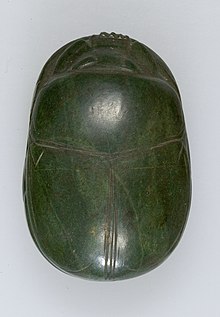

This article needs additional citations for verification. (March 2021) |

The heart scarab is an oval scarab artifact dating from ancient Egypt. Mostly an amulet, it was also used as jewelry, a memorializing artifact, or a grave good. The heart scarab was used by referring to Chapter 30 from the Book of the Dead and the weighing of the heart, being balanced by Maat, goddess of truth, justice, order, wisdom, and cosmic balance. The function of the heart scarab was to bind the heart to silence while it was being weighed in the underworld to ensure that the heart did not bear false witness against the deceased.[1] As in many current religions, the individual had to show 'worthiness' to achieve the afterlife. The heart was extremely important to ancient Egyptians as the seat of intelligence and the storehouse of memory. It was the only organ left in place during mummification. Heart scarab amulets were meant as substitutes for the heart should the deceased be deprived of the organ in the afterlife.[1] For example, when a person died, a heart scarab was often placed on their heart and bound underneath the bandages of the mummy. This was to ensure that it could not be physically removed from their person.[2]
| |
The amulets are described in the Book of the Dead to be made (per Andrews, Amulets of Ancient Egypt)[3] of a stone: nmhf, nemehef (not now identified); typically green stones, green jasper, serpentine, and basalt. Andrews continues to say they are in fact made from: green or dark-green materials, such as glazed steatite, schist, feldspar, hematite and obsidian; also blue-glazed composition (faience), Egyptian blue, rock crystal, alabaster or red jasper. Instead of the head of a scarab, heart scarabs had the head of a human and were often inscribed with chapter 30B of the Book of Going Forth by Day. Heart scarabs were also used in the design of pectorals, which were a rectangular chest ornament.[4]
The alternate heart amulet itself represents similar ideas, but is made in the form of the heart as used by the Egyptian-language hieroglyph.
| |
- ^ a b Andrews, Carol (2007). "Amulets" In The Oxford Encyclopedia of Ancient Egypt. Oxford University Press.
- ^ a b Liszka, Kate (2015). "Scarab Amulets in the Egyptian Collection of the Princeton University Art Museum". Record of the Art Museum, Princeton University. 74: 4–19. ISSN 0032-843X. JSTOR 26388759.
- ^ Andrews, 1994. Amulets of Ancient Egypt, chapter 4: Scarabs for the living and funerary scarabs, pp 50–59, (p. 56).
- ^ Bianchi, Robert (2001). "Scarabs" In The Oxford Encyclopedia of Ancient Egyptian Art. Oxford University Press.